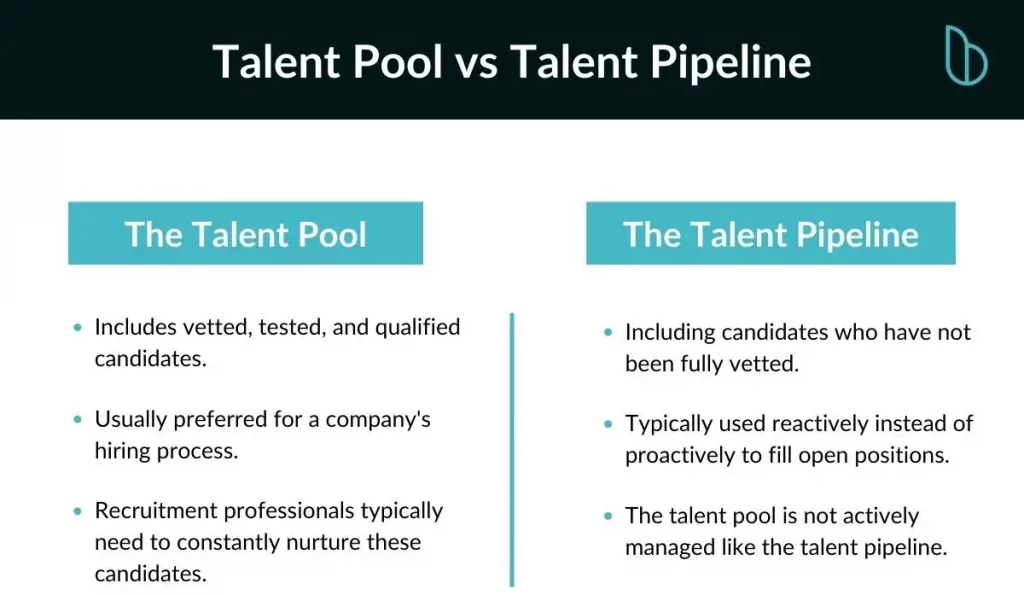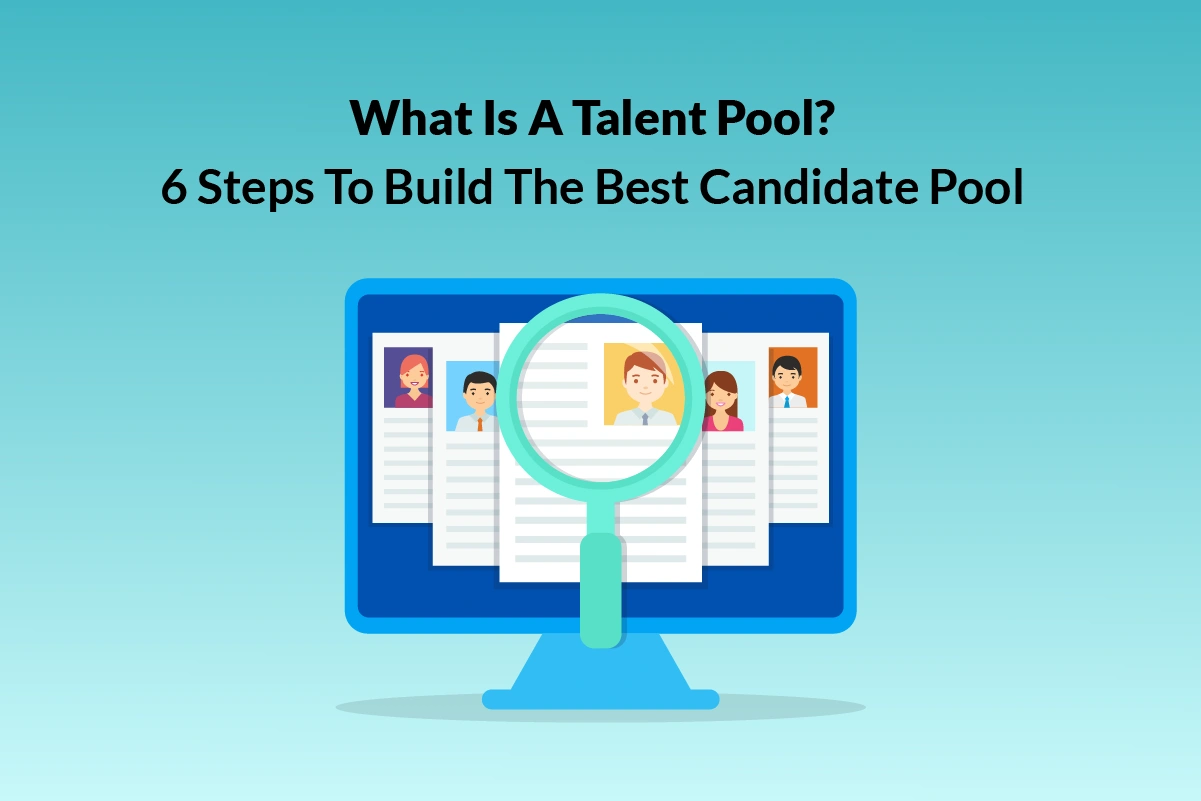The ability to find and attract candidates is becoming a top concern of businesses with the increasingly fierce talent competition. One of the ways they can improve employers access to talents when they need them is by building a talent pool.
So what is a talent pool? How to choose the most suitable candidates? Keep reading to find out how building a strong pool of candidate solves a key business need.

What is a Talent Pool?
A talent pool, also known as a talents network, is a database or list of potential candidates with which the recruiter keeps in contact. These potential candidates are those who can meet your company’s immediate and long-term needs and often come from sources like past applications, employee referrals and job events.
These candidates will be the first people you reach out to for future job postings. Having their information on hand and the pre-vetting work completed minimizes the time to fill open positions.
The talent pool will allow your organization to establish and maintain relationships with workers whose expertise and skills align with the company’s capabilities and values.
A proper talent pool database typically contains essential information about each candidate, including their skill set, the potential role they fill and how well they fit within your company’s culture.
Having a good talent pool will allow you to avoid starting the recruiting process from scratch every time a position opens.
Instead, whenever your company needs to fill one or more open positions, you will immediately turn to this pool of high-quality candidates who are already familiar with and interested in your organization.
Extend your talent network by submitting for any opening job posting:
Benefits of a Proper Talent Pool
Of course, the primary role of creating and maintaining a talent pool is to allow you to quickly access potential candidates who have the right skills and are willing to join the team when your company needs them.
Here are concrete benefits of a proper candidate pool:
- Reduce Recruitment Costs: Once you have a list or a database of potential candidates, you won’t need to spend a lot of money on job ads, which can be pretty expensive.
- Reduce Time in Recruiting: When you post your job on the common job boards, you could receive hundreds of applications from both qualified and unqualified candidates. Reviewing each resume and reaching out to the candidates takes a lot of time. With a list of talent that you are sure will be a good fit for your company. You won’t need to spend time researching and evaluating candidates, allowing you to reduce time in filling open positions.
- Raise Your Company’s Reputation: Many studies have shown that candidates who have had positive experience engaging with you are more likely to share that information with their acquaintances, enhancing your company’s ability to attract talent.
- Join Faster: Thanks to the previous exposure to your company via emails and phone calls, individuals need less time to decide whether you are the company they want to work for. As a result, time spent negotiating significantly shrinks, filling that open position much quicker.

Difference Between Talent Pool and Talent Pipeline
The commonality between a talent pool and a talent pipeline are that they include candidates interested in a position in your company and willing to join your team. However, there is a significant difference between talent pool and talent pipeline:
| Talent Pool | Talent Pipeline |
|---|---|
| Includes vetted, tested and qualified candidates. | Including candidates who have not been fully vetted. |
| Usually preferred for a company’s hiring process. | Typically used reactively instead of proactively to fill open positions. |
| Recruitment professionals typically need to constantly nurture these candidates. | The talent pool is not actively managed like the talent pipeline. |

The Talent Pool
A talent pool includes vetted, tested, and qualified candidates ready to fill positions when they open.
Candidates in a talent pool are often the preferred candidates for a company’s hiring process.
Recruitment professionals typically nurture candidates so they can hire them quickly when a job opportunity opens..
The Talent Pipeline
A talent pipeline includes potential candidates who have expressed their interest in joining your company. These candidates have not been fully vetted to enter a talent pool.
These candidates are typically those who attended a career fair and engaged via chatbot or Text to Apply but were ultimately not chosen to fill a role.
How to Build and Maintain a Diverse Talent Pool?
Following are some ways that will allow you to build a proper candidate pool :
Add Sourced Candidates
Whenever you come across talent that’s interesting but doesn’t fit into any of your company’s current open roles, make sure to add them to your talent pool, tagging them with the role they could qualify for.
Start Interacting with them regularly, keeping them up to date with the latest technology developments at your company, industry news, or inviting them to your company’s events.
Make a Dedicated Landing Page
If there are candidates who like your company but haven’t had the right opportunity, you should have an alternative for them to engage. The best way is to create a dedicated landing page that they can join to stay up to date on job openings, company growth and awards.
Engage Students or Graduates-To-Be
Engaging soon-to-graduate individuals nurtures your future workforce. Making sure that your brand is top of mind when they graduate and are seeking to start their career.
Be open to engage with students that aren’t yet looking for a full-time contract. They are a great resource to fill part-time positions and you can start developing them for their future career paths at your company.
The same goes for graduates, albeit in a slightly different way.
Social media is the best way to reach students and graduates. For these individuals, you can consider graduate programs, (summer) internships, part-time contracts, or job shadowing as a couple of different ways to engage them before making a full time hire..
Build The Talent Pipeline
As mentioned above, a talent pipeline includes vetted, tested, and qualified candidates, people who are willing to fill your open positions in no time. These candidates are often given priority in each hiring process and may also be suitable to fill senior positions. Building a talent pipeline is a great way to avoid a bad hire to your business.
Keep Potential Candidates Who Aren’t Ready to Apply Interested
You may see a great fit with some candidates interested in your company but lacking the right experience or who are temporarily living abroad, for example.
When building a talent pool, you shouldn’t be too picky. So, even if someone is currently on a long sabbatical or still in college, they still deserve to be on your list if they have an interesting profile.
Don’t forget to give them the right content to keep them interested and ready to fill open positions when they’re ready.
Don’t Ignore Your Former Employees
You also shouldn’t ignore former employees when talking about building and retaining your candidate pool.
Just because your former employee has left your company does not mean they are not interested in future opportunities. This is especially true when their reason for leaving is unrelated to a disagreement between them and your company.
So keep in touch with potential former employees. One day, like a boomerang, they could come back and continue to work for you.

FAQs about Talent Pool?
Can I use a talent pool to fill a role at a higher grade?
We strongly recommend avoiding using a pool of candidate to fill a higher role for the following reasons:
- It creates inequality for candidates who miss out on a chance to apply for a higher-level role.
- The capability requirements of the higher graded role are generally not suitable for candidates in your talent pool as they have not been vetted, tested, and qualified.
For senior positions, candidates in the talent pipeline tend to be a better fit.
Can I use a talent pool to fill a role at a lower grade?
The answer is yes. The lower grade positions are often suitable for candidates in your talent pool.
How can I minimize bias when selecting from a talent pool?
Here are some solutions that allow you to minimize bias when selecting from a talent pool:
- Remove gendered wording
- Introduce blind skills challenges
- Applying data-driven recruitment strategy
- Have an interview panel
- Require anonymous test assignments
- Leave politics out of it
- Grade candidates on a rubric
Hope this article is helpful to you. Thanks for your time!
References
- Goverment, L. F. (2021). Talent Pool FAQ. Leicestershire: Leicestershire Fire And Rescue. Retrieved from https://leics-fire.gov.uk/wp-content/uploads/2021/12/talent-pool-faqs-v3-final-20-sept.pdf
- Government, N. (2020). Talent pools guide for HR and hiring managers. New South Wales: NSW Government. Retrieved from https://www.psc.nsw.gov.au/sites/default/files/2020-11/Talent%20pools%20guide%20for%20HR%20and%20hiring%20managers.pdf
- Jobvite. (2017). 4 Steps to Build a Rich Talent Pool. California: Jobvite. Retrieved from https://www.jobvite.com/wp-content/uploads/2017/01/Jobvite_eBook_How_To_Build_A_Rich_Talent_Pool-v1c.pdf

